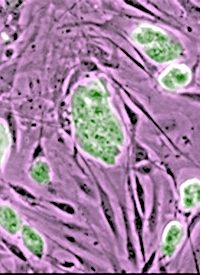
Researchers in Germany announced that they have used adult stem cell therapy to cure a man afflicted with both leukemia and HIV, the virus that causes AIDS. Writing about their research in the December issue of the medical journal Blood, doctors from the Charite-University of Medicine in Berlin explained that in 2007 the 44-year-old American patient, Timothy Brown, volunteered to receive the experimental adult stem cell therapy to treat his leukemia. At the same time, the researchers decided to perform a stem-cell transplant in an effort to fight his HIV. Not only was the stem cell donor a good blood match for the patient, wrote the researchers, but he also had what the doctors determined was a gene mutation that demonstrated a natural resistance to HIV.
Now, three years since the treatment, researchers say that Brown shows no signs of either leukemia or HIV infection, and they are guardedly optimistic that he has been cured. The researchers say that Brown was taken off anti-retroviral drugs in February 2010, and neither disease has shown signs of return in the 20 months since the transplant.
“In conclusion, our results strongly suggest that cure of HIV has been achieved in this patient,” wrote the German researchers.
While showing strong interest in the case, medical experts have nonetheless expressed caution in some cases, pessimism in others. “Cured is a strong word,” said Dr David Scadden, a co-director of the Harvard University Stem Cell Institute. “But this is very encouraging … from all indications, there was no residual virus.… It’s as good an outcome as one could hope for.”
Dr. David Prentice, a former biology professor at Indiana State University, told LifeNews.com that while the evidence provided by the researchers is compelling, “Caution is still the byword…. These types of transplants are not gentle, and the virus could still be hiding and waiting.” He pointed out that all such transplants “would require finding bone marrow adult stem cell donors with the particular mutation … so this will not be a widely-applicable treatment.”
Dr. Michael Saag of the University of Alabama at Birmingham, who is past chairman of the HIV Medicine Association, told the Associated Press (AP) that while the case demonstrates that “with pretty extraordinary measures a patient could be cured of HIV,” the experimental treatment remains too risky at this point to become standard therapy for AIDS treatment, even if good donors could be found.
Saag said that blood stem cell transplants are done routinely to treat patients with cancer, but that broadening the treatment to other, relatively healthy individuals (such as someone with HIV but not AIDS) remains risky because it means destroying an individual’s own immune system using both powerful drugs and radiation, and then developing a new immune system for the patient, using cells from a matched donor. He said that the mortality rate for such a procedure could be five percent or greater.
Noting that drugs can typically keep HIV from developing into full-blown AIDS in most patients, Saag said that the only way the procedure might become an option is if a patient had both HIV and cancer, as did the patient in the research. “We can’t really apply this particular approach to healthy individuals because the risk is just too high,” he said.
Commenting on the case in 2009, Dr. Anthony Fauci of the U.S. National Institute of Allergy and Infectious Diseases emphasized that the experimental procedure would be too expensive and risky to become a common treatment in the near future, but that the research may aid in the development of gene therapies for the treatment of HIV.
Most recently, Fauci told Fox News that while the patient in the German case appeared to be “functionally cured,” results would most likely not carry through for every HIV-positive patient. “This is not prime time to me at all,” he said. “This is a very unusual situation that has little practical application for a simple reason. This donor not only had to be a good compatible match, but the donor had to have a genetic defect of cells that do not express the receptor that the HIV virus needs to enter the cell.”
He added that the risk is great. “This patient is trading one poison for another,” he warned. “He may not have to be on antiretroviral drugs anymore, but he has to take immunosuppressant drugs now to prevent the rejection of his transplant cells.” He concluded that “what this is, is an interesting proof of concept, but it’s absolutely impractical.”
However, not every medical expert expressed such pessimism at the prospect for success with the treatment. Dr. Thomas Quinn, director of the Johns Hopkins Center for Global Health, told Fox News that the latest research “looked much deeper into whether HIV could still be present or lurking in the body in some way, not cured, and since the transplant [the test patient] remains viral free and his cells appear to be resistant to infection.”
He added that while there is still much research to do, the latest news “gives hope to the millions of people infected with HIV that cure is a feasible option in the future.”



